This is a re-post of my Ogilvy Consulting whitepaper –Subscribe. If you are looking for the german PDF version – it’s here: Ogilvy_Whitepaper_Subscriptions
Some facts and figures have been updated.
Subscriptions – do you still buy or do you already subscribe?
Contents:
- The innovation Challenge
- Subscriptions
- What does the market tell us about subscriptions?
- Subscription types
- Reasons to move to subscriptions
- Subscription customers
- The road to a subscription first company
- Guiding principles to kickstart you
- About Ogilvy Consulting
Summary/ Abstract
The growth of subscription-based business models over the past decade has been astonishing. Subscription businesses grew revenues about 5 times faster than S&P 500 company revenues. Why is that and how can others participate in this hypergrowth? Let’s look into the subscription business model. One of the key drivers for this is the shift to consumer-centric thinking, ongoing innovation, and the concept that we know as the perpetual beta of constant improvement but a never-finished product or service. This has been enabled through data and new production- and delivery methods.
In this whitepaper, we look into the route to subscription, investigate some alternative and complementary approaches on business models and innovation, and weigh the advantages and challenges of the subscription model. In the end, we show some guiding principles for subscriptions that are common to a lot of segments from B2B to B2C and from Product to Service.
- The innovation challenge –
Innovation is the driver of 21st-century success
We all know what the Kodak moment is, we all know the one more thing Steve Jobs used to finish his Keynotes. And we all know the numerous brands that came up through innovative business models within the last few years. Be it AirBnB disrupting the classical hospitality business, Uber the taxi business, or Netflix putting the final nail in the coffin of Blockbuster. All these examples have one thing in common. They innovated. Even if we look into Netflix and Blockbuster – with similar starting positions – both were rental companies for DVDs. Netflix was the one to innovate with home delivery driving the convenience aspect ant the CX to the max while Blockbuster stayed in its bricks-and-mortar business.
Even German B2B global champions – as they like to call themselves – finally woke up and realized that in order to survive they will have to start moving their believes no matter if this is a giant like Volkswagen or an SME from the German countryside producing the best car parts you can buy on the planet.
„When memories exceed dreams, the end is near. The hallmark of a truly successful organization is the willingness to abandon what made it successful and start fresh“ (Friedman, 2005)
Issues and trends
We live in the information age. Efficiency will soon be a thing for machines. We have to innovate with new products and services.
The truth is – and this is especially true for a high-level industry nation as Germany – that the strategy of producing something in the most efficient way with the highest possible quality soon won’t be enough to stay competitive on a global scale – because a machine will be able to do the same thing even better, cheaper and faster. So with machines becoming more agile, more multipurpose, and cheaper we may even start to see a point in the future where the advantage of best-in-class engineering will end. There’s an expected 20 million factory jobs to disappear by 2030. Oxford Economics found the more repetitive the job, the greater the risk of its being wiped out. Jobs which require more compassion, creativity, or social intelligence are more likely to continue to be carried out by humans „for decades to come“, it said. The firm called on policymakers, business leaders, workers, and teachers to think about how to develop workforce skills to adapt to growing automation. About 1.7 million manufacturing jobs have already been lost to robots since 2000, including 400,000 in Europe, 260,000 in the US, and 550,000 in China, it said.[1] So as long as we innovate we are safe.
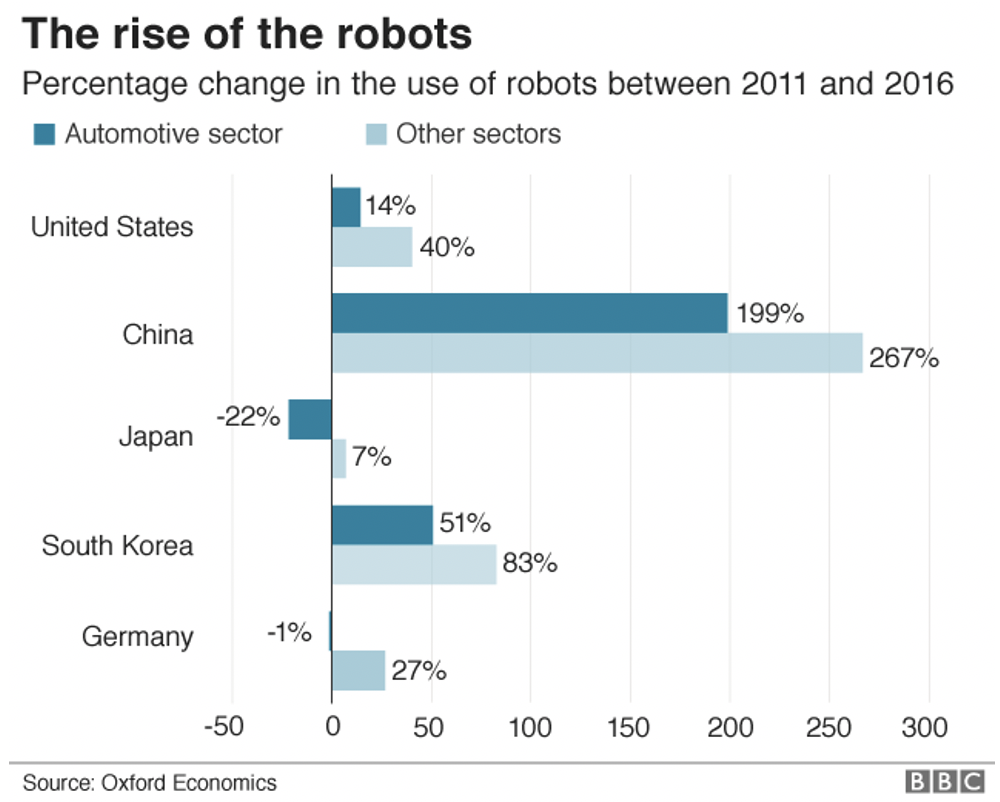
Graphic 1 – The rise of robots.
User experience beats best price and lending is the new buying.
Coming back to the example of Netflix and Blockbuster. Blockbuster might have had a cheaper out of the pocket payment (no postal charges) but Netflix had the better experience (delivered to your door in one day). The new service – the innovation – in the end, succeeded over the driver of efficiency. Even though their product – the rented movie – was exactly the same.
We can see this for quite a while with buzzwords arriving and leaving. Still, remember the sharing economy? It’s also part of this – even though the utopia of all of us sharing everything was very quickly changed to an actual much more realistic model of a decline in ownership of things and a trend to buy “short-term” access to something we want or need in this instant. The latest hype was Lime and all the other e-scooter providers. Still it’s safe to say the megatrend from ownership to access/ usage is here to stay.
The expectations of consumers changed.
So what’s the real problem and why it should be solved
9 out of 10 products disappear in first year after launch, classical innovation is slow, all in
and a failure might end up in bankruptcy.
Innovation of course is nothing new. It’s been done since we exist. That’s why there are R&D departments, why we have fundamental research in universities, and to an even bigger extent why we play. The drive for innovation, for something new, is embedded in us from the earliest age of our childhood. We try, we fail we try something else and we succeed – but we do. The problem we see in the market today so it seems can be found in the first part. We try – we fail. We try a one size fits all model of growth and innovation. By doing what we have done for the last 50 years. This is why we have so many failed innovations. This is why 9 out of 10 products on the shelves disappear after the first year, this is why 9 out of 10 startups fail. But in the worst case – and just to mention some well-known examples of bankruptcy – this happened to the DMC12 – DeLorean – from the DeLorean Motor Company – well known through its role in the back to the future movies, it happened to Segway – and with not so dire results as bankruptcy but as a massive PR debacle to New Coke from Coca Cola in am amateurish try to meme the taste of Pepsi.
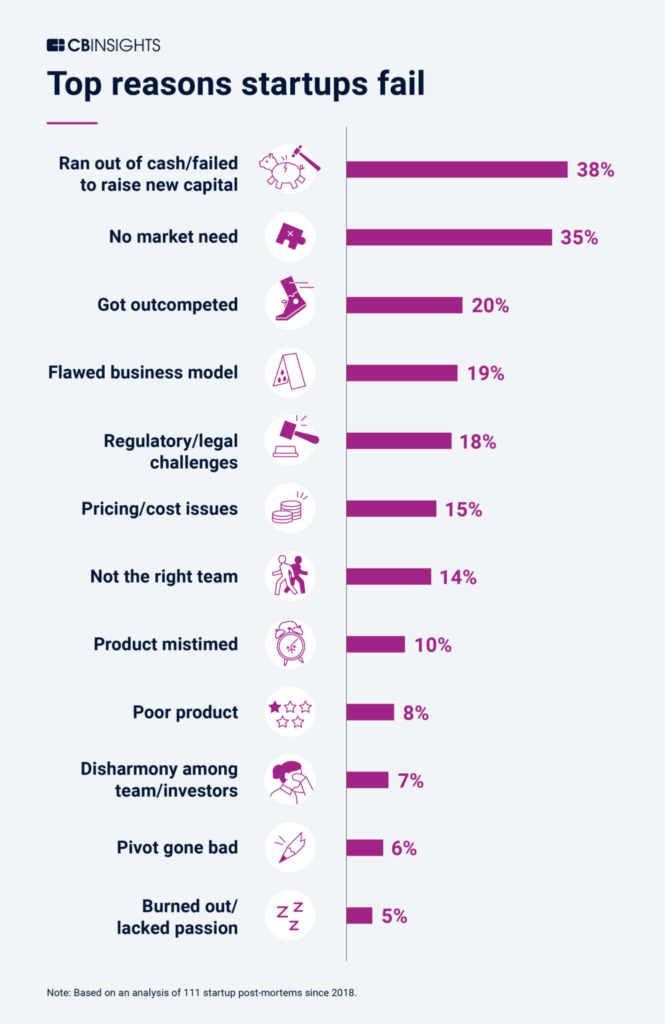
Graphic 2 – The Top 12 Reasons Startups Fail. [2]
As kids we seem to do this better, we first look at what’s happening around us. We analyze we learn from others we fail quickly and iterate on this. We are agile in the truest sense of the word.
However, the underlying problem of a big part of these failures is that the innovations were developed behind closed doors (e.g. Graphic No 2 . “No market need, cost issues, user un-friendly product, ignore customers…) following a standard approach by specialists up to a final product that would be launched with the objective sell or else… So a massive investment lacking customer insights and a fundamental understanding of whether or not, the consumer or customer would want it, would need it, or would even be willing to pay for it. And there’s the issue – paying for it. The company was paying for it. Of course, clients have to pay for it – otherwise, the product or service is unsustainable.
Well, thanks for stating the obvious – but how high can the price be to attract a necessary sizable number of buyers. 50,- € 100,- €, 2000,- €, 10.000,- € a million? (that last price tag might come in handy when we look into B2B)
You might ask now what this has to do with subscriptions. It’s the up-front investment for both. The company and the client likewise. Why should a company invest billions (e.g. like Quibi[3] with an obviously flawed service and UX) without ever talking to their customers? And why would customers invest the mentioned prices for something they never tried before. Is there a possible solution to this chicken–egg-like problem? Here’s your answer – a subscription can be a solution.
- Subscriptions
One solution
A subscription would solve the high up-front investment for consumers and customers. If it follows the current subscription model with the possibility to quit and restart on a monthly base probably even more. There’s no more barrier to subscribing to something. As a consumer if I don’t like, need or use it anymore, I simply stop it.
A subscription significantly lowers the barriers for consumers to get to use the companies offering in the first place. During this time consumers are usually also willing to feedback on what they experience and how they use something. So they produce data for us that we can use to improve on our product in ways and with a speed that was not possible before.
A maybe unexpected example is the heating as a service offer of Viessmann. Instead of purchasing and installing my central-home-heating system, I subscribe to it for a period of 20 years – installation and maintenance included – giving consumers the advantage of a lower out of pocket payment – a hassle-free experience with their heating system and Viessmann the usage data of their equipment over this period of time – at least that’s what I’d expect them to do.
For companies, the subscription might be an attractive option worth investigating. A subscriber provides a constant recurring cash flow – every month. Even though subscriptions are harder to sell [4] after getting one it’s not the classical hustle with a sales team that tries to achieve their targets during a month. No subscription money just flows in, at the beginning of every month. It can be used to pay the bank, the innovators, the marketing, and the whole company. Cash flow gets much easier to manage. We move away from this all-in bet on one new product with maybe some revenue for service down the road.
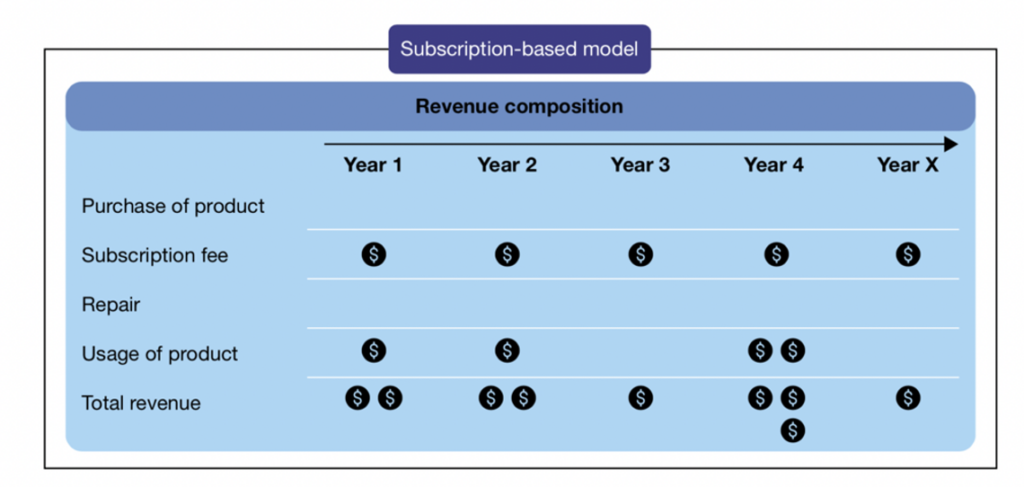

Graphic 3 – Comparison of subscription revenue vs. classical one-time purchase revenue [5]
But would this be valid for the mentioned examples? Well, Netflix moved there and is rather successful. Cars – we can see some models for it popping up at the moment – of course in the luxury and premium segment first. For Segways definitely – the price of 5k for one Segway was simply too much and for beverages? – why not have a drink subscription with new taste offers every month and iterate on how consumers feedback on them – so use mass behavior instead of some experts.
With subscription being one solution let’s also look into some alternatives.
During the last years, quite a lot of different solutions for a successful innovation came up. And they are not just business model driven but rather various in their types.
We can co-create with consumers and clients. It’s easily done to conduct crowdsourcing of ideas and feedback. We have options like Kickstarter or smoke tests where we use renderings, sketches, or other means to visualize, present and test an idea with a big crowd and where we see if the product or service will find enough consumer support to be scaled to a full-scale business. Digital production methods and e.g. 3D printing makes even the production of only a low quantity for testing affordable. And with a global market to serve, consumer needs and consumer ideas of the perfect service or product are also rather different.
And for the business model perspective well even here we see alternatives to the one-time upfront paying for a product. Popular options are pay-per-use. With Uber, I only pay when I use a driver. With AWS (amazon web services) I only pay when I use a service e.g. like picture analysis or webspace or a cloud server that is only activated when my serverless application needs more capacity – this enables a highly scalable service offer without buying a giant server park.
Freemium models allow the use of some basic features and I pay when I want to use a better service or some additional features. It’s very common in Apps but we can also the pay-per-feature approach in Tesla cars. Where all the technology is built-in and if I want to have a higher reach I pay for it and the software will enable me to use it – so why build three different types of cars and not one car and completely automate the production process with the corresponding scale and price effects.
And we also have to be honest about the differences between disruptive innovation and an evolutionary innovation. Making a disruption will always involve more uncertainty and a higher risk than an evolutionary iteration on product features and improvements.
- What does the market tell us about subscriptions and are they new?

Graphic 4 – Subscription business sales have grown substantially faster than two key public benchmarks—S&P 500 Sales and U.S. retail sales. Overall, the SEI data reveals that subscription businesses grew revenues about 5 times faster than S&P 500 company revenues (18.2% versus 3.6%) and U.S. retail sales (18.2% versus 3.7%) from January 1, 2012, to June 30, 2019. Companies in the SEI are adding new customers at a rate of 15.4% annually on average, and their subscription revenues are growing at a rate of 18.2%. Revenue growth is composed of both customer base growth and ARPA growth.[6]
An iterative innovation model seems to be the driving force in the market. And this approach also needs a corresponding business model. Subscribing as a general way of thinking and structuring a business delivers this model. An ongoing iteration of the product, a co-creation with consumers, and the collection of data are all favored by a subscription. Consumers and customers actively drive the development of the product or service they are using. If they need an additional feature, they buy it. If they don’t need it anymore, they downgrade again. This gives the consumer the ultimate freedom of use and the provider valuable insights and the necessary constant cash flow to improve the offering. And even for disruptive innovation, we can ensure a much higher rate of success as the need for such innovation will derive from the actual user behavior and not from some more or less biased form of market research. Of course, this is slightly different for products, services, and again for software.
Steve Jobs already mentioned that consumers don’t know what they want until you show it to them. With an ongoing analysis of their behavior, however, we are as close as we can currently get to their actual desires and needs. And this counts for B2B and B2C offers alike. Predictive analytics might tell me that a machine keeps breaking down again and again because of the specific way our client uses it which would enable us to innovate for a machine custom-built to this need.
While the analysis of our use of the Thermomix tells Vorwerk when we cook, what we cook, and what a next generation of the tool might need to deliver to keep consumer satisfaction high.
Subscriptions are here to stay – But they are anything but new.
Subscriptions are nothing new. We all know them and we all have at least one subscription. How? Well – Wikipedia states a subscription as: “Rather than selling products individually, a subscription offers periodic (monthly, yearly, or seasonal) use or access to a product or service“
So speaking in this direction any apartment rentals or car leasing, any phone contract or service level agreement, any fitness studio sign up or the Youtube channel you follow and even the Payment in installments you choose for your new motorbike is a subscription. And it doesn’t stop there. Electricity, cable tv, internet access, Spotify, Netflix, apple tv+, Disney+, amazon prime, dollar shave club, Patreon, Salesforce, SAP, AWS, Statista, Porsche Drive, Private Jet XO… the list goes on and on and on.
Then is the reality of the success of subscriptions is merely a wording thing?
Well it’s not that straight forward but part of the success might really come from free online media platforms like Youtube: “If you liked this video then please like, comment and subscribe to our channel”
-> It’s that easy.
And not just the previously mentioned financial success of the companies, but also the number of consumers opting in for a subscription in e-commerce shows this trend.
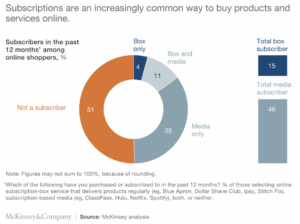
Graphic 5 – Subscribers on the past 12 months among online shoppers in %[7]
- Subscription types –
Following a McKinsey study of 2018[8] there are three major types of subscriptions. These are Replenishment, Curation, and Access.
Replenishment subscriptions allow consumers to automate the purchase of everyday items such as razors, nappies, or coffee. Curation subscriptions aim to surprise and delight by offering new items or very personal experiences in categories such as clothing, beauty, and food. Finally, access subscribers pay a monthly fee to receive lower prices or discounts for members, which can give the impression of being VIP, especially in the categories of clothing and food. Curation services are by far the most popular, accounting for 55 percent of total subscriptions, indicating a strong desire for personalized services. Refill services account for 32 percent of subscriptions and access subscriptions for 13 percent. We have to see that these are merely e-commerce subscriptions. And if we look into the segment of digital media subscriptions it would already be harder to push e.g. Netflix into one of these categories – Netflix provides access and curates a personal film experience.
“My favorite thing is that they have a ‘suggested for you’ feature based on what you’ve watched.” — Media-streaming subscription user [9]
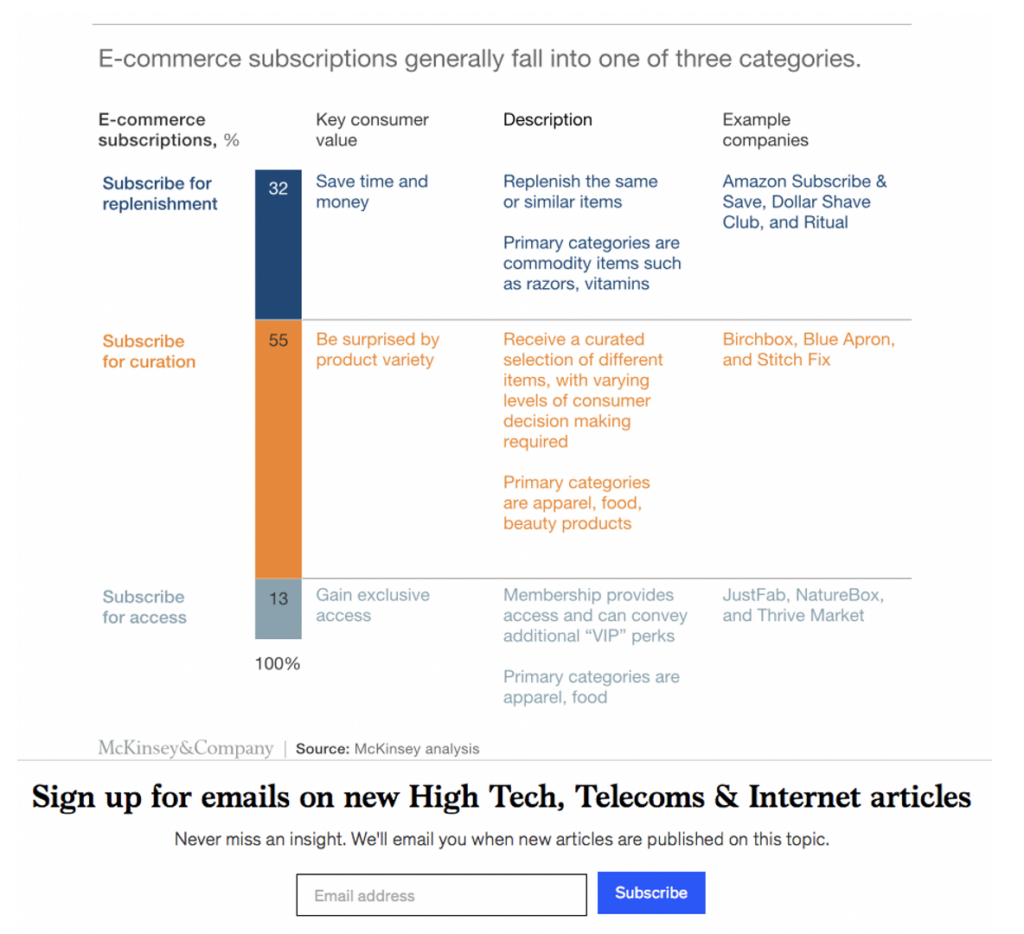
Graphic 6 Three broad types of subscriptions[10] – including an easy way to sign up for a newsletter subscription.
Also, this view doesn’t include the whole segment of B2B subscriptions – so anything as a service. Forrester aimed at a subscription segmentation in combination with the overall service promise that we can see popping up everywhere in the last years. Name-it-as-a-service. This is probably more comprehensive but in some ways less specific.

Graphic 7 Subscription models segmentation[11]
Both tables give us a rough overview of subscription models both are correct and none of them are complete. Still, they give us important guidance when setting up the subscription model for our business and a first idea of what we want to be. Are we product- or service-driven? Exclusive or open? Commodity & convenience or curation & delight? This brings us to the next point on our way to a subscription
- Reasons to move to subscriptions.
For companies, customers, and sustainability
There are three perspectives to mention when it comes to the reasoning for a subscription. With you probably being an employee of a company thinking about possible innovations and the future of your business model let us start with the company perspective.
- A subscription drives a more predictable and linear revenue. This makes planning much easier, leads to a better cash flow, and calms down the finance department.
- Potentially increase your business value. A more stable cash flow and better financial planning can lead to a lower risk rating for the company better valuation among Investors and an easier way to invest.
- A subscription opens up new opportunities to deliver value to the customer. What do we mean by that? Well in contrast to selling your product once we have a symbiosis with our subscribers. They use our product – preferably our services surrounding it and produce data that we can use to improve these services, to create new services, and to attract different user groups we might not even have considered before.
- Enable upselling and cross-selling. The data we have but also the consumers we constantly have in our subscriber pool will open up possibilities to upsell and cross-sell. Remember Amazon prime? It used to be free delivery, now it’s also a way into the whole media offering of Amazon.
- It can improve our position next to start-up challenger in the category. One of the first things start-ups do today is buy server space and AWS services to scale – and a lot of them do so with a subscription model. So let’s be faster and offer a proven product or service on a subscription base instead of waiting to be disrupted by a worse product but a better offer. E.g. it is rather expensive and harder and harder to sell garage equipment to small free garages in a one-time payment. So why not offer it as a PaaS with a low fee (including updates) and a Pay Per Use for every service they conduct with it? This would build another wall for new competitors to overcome when entering the market. The service machines are built anyway.
- Higher loyalty & engagement. Lower churn and retention costs. It’s no secret that a lot of fitness studios only survive because of the numerous subscribers who forgot to quit their new years‘ resolution sign up. However, the truth is that an open subscription program (where I can quit monthly) actually has a high retention rate. The aspect of convenience cannot be stressed enough. In the end, Subscriptions are primarily a retention program.
Now for the consumer or customer perspective.
- Since the sharing economy took off people only want to use something as long as they need it [12] (or better the value it brings them) – the subscription models respond to that. And Subscription-based offerings need to be even more human-centric because otherwise, customers will easily unsubscribe. You can trick almost anyone into buying a shitty product once using marketing techniques but you cannot trick someone into continuously using it and paying for it although it is of zero value.
- Better user experience. With the user being able to opt-out from the subscription at any time it becomes essential to create the best possible user experience with a high product and service quality that can constantly improve. A staggering 76% of consumers expect companies to understand their needs and expectations.[13] Subscriptions enable data collection, analysis, and iterations on our product
- They have greater buying flexibility & higher ROI. Looking back at the garage example. It’s a massive investment to pay a machine one time upfront with 10k or an even higher price. But if you subscribe for it with a monthly fee of let’s say 100,- € and you pay an additional fee of 50,- € per inspection it becomes interesting for any small garage and for a lot of consumer products alike. This ensures liquidity even for SMEs and a higher ROI as they can test any offer with a lower risk.
- Real-time maintenance of products and services. This is not a subscription benefit per se as more and more products are becoming equipped with sensors to track their usage and user real-time monitoring of their performance and predictive maintenance (changing a part before it breaks to avoid downtime and ensure production) becomes a clear benefit of the product and service offering. Such a service is usually at least included in a modern service level agreement. Rolls Royce is doing this for decades with their jet engines that are usually leased to the plane companies who pay for each used hour. Another good example for this might be Manufacture #LikeaBosch by Boschrexroth ensuring uptime of a factory by IoT
- Ensured security against malware and cyberattacks. If consumers pay for the actual usage of a device or a service the consumer is giving away the responsibility for the functionality and the uptime of this device to the provider. So the provider also has to ensure security against malware or cyberattacks because otherwise the usage would be limited
- Less clutter at home and at work. One major benefit of a PaaS subscription is the availability of the latest technology and latest device generations. In Germany alone, people have an estimated 200 million old mobile- and smartphones at home – forgotten in drawers and tech boxes that we might need again one day. The same is also the case for companies alike. A subscription that eliminates ownership can resolve this problem of too much old electronics and machinery but also of too many e.g. CDs or DVDs at home as we just stream them from Netflix or Spotify.
This last point also brings us to an aspect that is very often forgotten when looking into subscriptions.
- Longer product lifecycle & circular economy. If a company offers a product as a service, they have to make sure the product works as long as the consumer pays for it i.e. as long as the consumer uses it (likewise for B2B customers). So the longer a product works and the less downtime it has the better it will be for my subscription cash flow. Also, the easier to repair a product is, the easier and faster it will be for my service personnel to fix it and therefore cheaper again. So by default, a subscription economy will lead to a more sustainable economy with higher longevity of products. The same can be said for smartphones or anything else. Ask yourself an honest question. How long will it be possible to put more cameras in the latest iPhone before it becomes ridiculous? This is also the reason why Apple is moving slowly away from product sales and towards an overall service offering where you only subscribe to a service that includes a phone but also complete access to Apple TV, Music, and whatever they might come up next. So it is actually in the best interest of the supplier to make the device refurbish able, reusable, and easy to fix. And with an ever-rising market sensitivity for a circular economy, the depletion of natural resources and sustainability in general companies can position themselves in this direction. OnRunning is doing exactly this with its Cyclon Shoe[14]
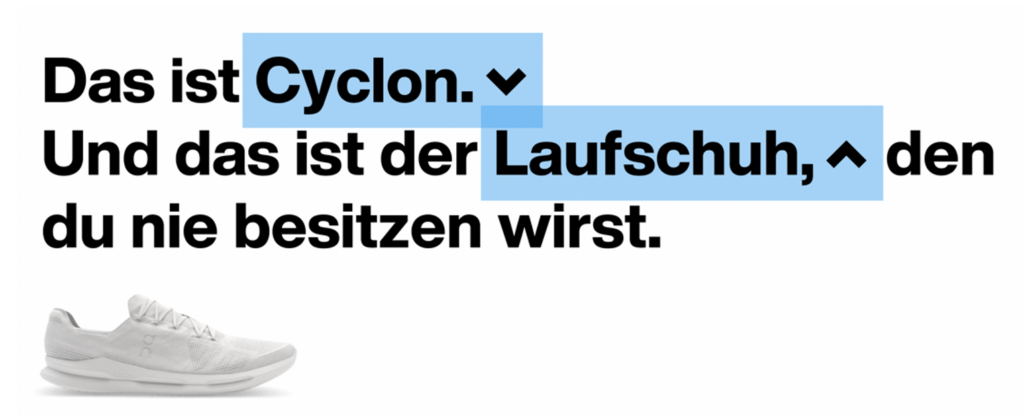
Graphic 8 OnRunning Screenshot “This is Cyclon. The running shoe you will never own”
And what are the outcomes?
Data is the new currency and subscription enables you to mine it.
The biggest advantage of the whole subscription business however is yet to come. It’s the data our users produce every time they use the service. Every time they use a product and every time they reorder and even if they don’t. Any subscription is an always-on program that constantly produces and collects data. And this also makes a subscription offering never final. The always beta is the new norm.
Consumer behavior might change over time with new innovations new services, new norms, or trends in society. If we keep bringing products to the market, this shift might happen in the middle of an innovation cycle. New services and even new products and features can be developed according to this data input and this changed behavior with a much smaller margin for error and a higher probability for success. So embrace the data.
- Subscription customers
Who are we aiming at with subscriptions?
It completely depends on your offering. As laid out before there are quite some aspects for companies to choose a subscription mainly because of better liquidity, more secure planning, and access to the latest technology and products.
For the consumer market, we can again take a look at the research McKinsey did. Overall more women are subscribers but men have more subscriptions. Additionally, we can see there that subscribers are between 25 and 44 years old and have an average income between 50.000 and 100.000 $ and they live mainly in urban areas.
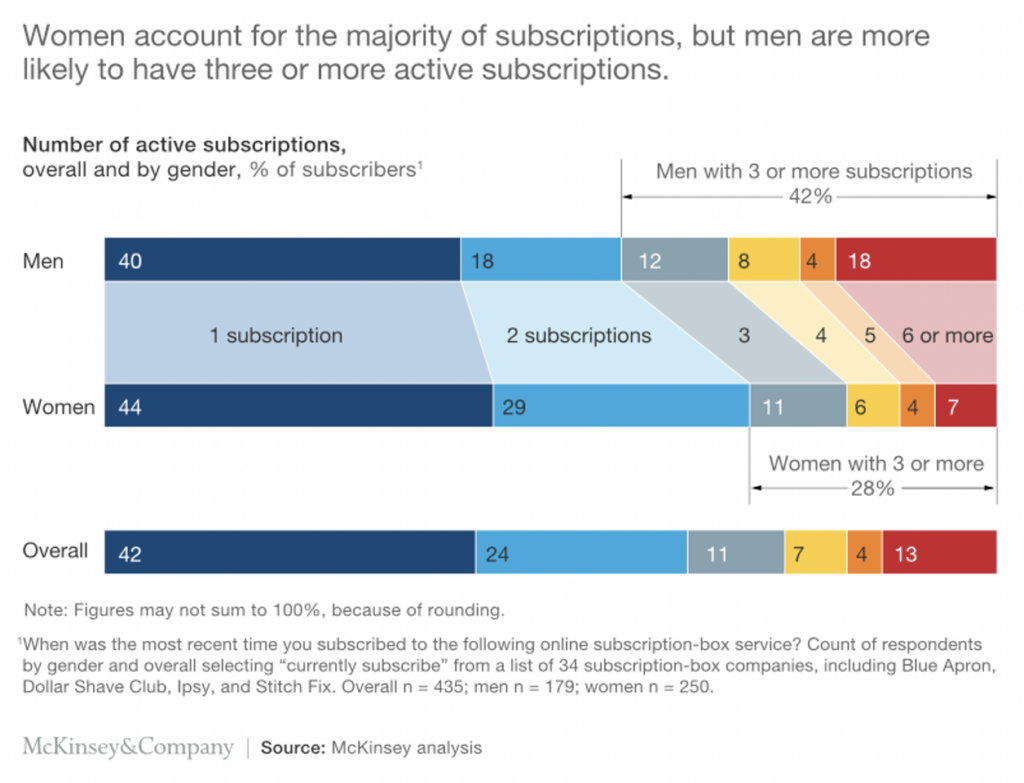 Graphic 9 Subscribers[15]
Graphic 9 Subscribers[15]
And what are subscription drivers?
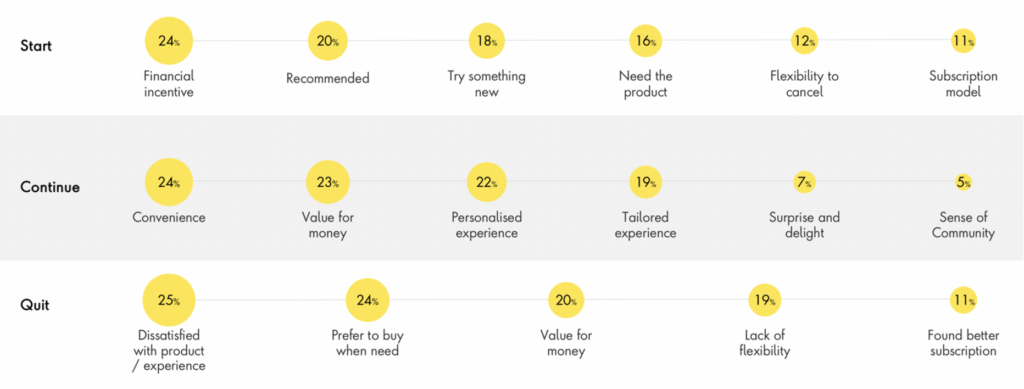 Graphic 10 Excerpt reasons for subscribers to start, continue or stop a subscription[16]
Graphic 10 Excerpt reasons for subscribers to start, continue or stop a subscription[16]
When looking into triggers for subscribers, we can find some rather common themes. Triggers are similar to a normal purchase there are promotions – financial incentives – and recommendations as to the biggest trigger. For staying in the subscription, we then have to ensure a high measure of convenience and a good value for money experience while personalizing the offer – which is a rather high challenge, that is probably easier done with digital offers than with actual products.
For consumers quitting, the reasons are also rather straightforward. The main reason being dissatisfaction with the product or the experience, no need for regular service and the preference to buy it when you need it or simply a lack of flexibility for example if I cannot pause a delivery when I am on holiday. This is also reflected in the German word “Abofalle” – (subscription trap) meaning a subscription offer that you buy but where it will be super hard to opt-out of again. Which has been prohibited by the German government only recently.[17]
Is subscription an acquisition or a retention offer?
We can say that subscriptions work for both objectives. The acquisition of new customers and the retention of existing customers. There’s a small difference in the behavior of these two groups for new customers the idea of a lower price to gain access to a product or service is the key driver while for existing customers added values gained through a subscription e.g. the insurance of a working device or also experiential benefits like exclusive access to events or premium services are the key driver for retention. It’s therefore extremely relevant to tailor offers according to the current business target a supplier has – are we aiming to get more consumers or are we aiming to keep our current customers.
Coming back to the Jamba – Abofalle, we also have to mention that the funnel for a subscription we can also see the reason that makes it so hard to acquire consumers for a subscription – the barrier to sign up is rather high if they are unsure they could quit it again at any time. The funnel in the McKinsey study only showed a conversion of 8% overall different subscription categories.[18]
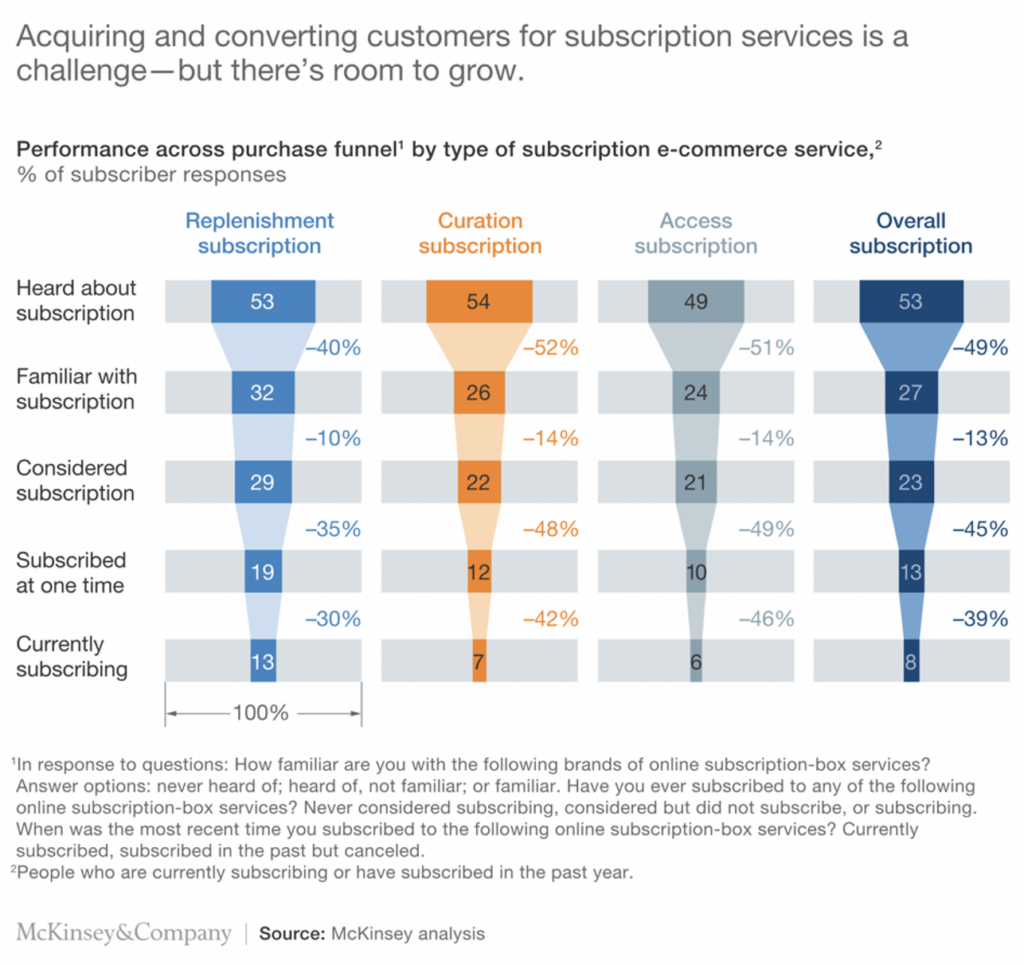
Graphic 11 Conversion to opt-in a subscription [19]
Most of us as consumers have experienced how it feels after signing up for a subscription. You receive a super genius offer that will have a cheap price for a couple of months. And after signing up for it, you will never be able to reach customer service and the only contact point you have are your monthly invoices that keep growing even though you opted in for a flat rate that surprisingly doesn’t cover any of the things you regularly use.
To not become one of those you have to change your classical business model away from the product to service design and into becoming an experience provider. The product if there is one – becomes merely an enabler for everything else. The smartphone becomes a commodity to communicate and consume media, the jet engine the means to move a plane. The revenue is produced by the services surrounding it and the content in it. So the experience a customer will have, e.g. media consumption or transportation.
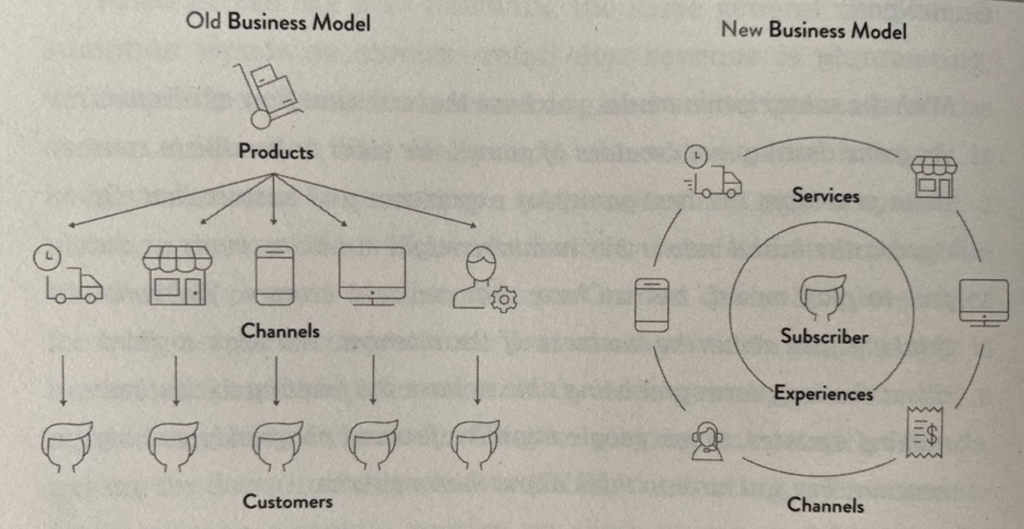
Graphic 12 The old vs. the new business model. It’s not anymore about getting a product into the market and selling as many units of it as possible, it’s about delivering the best customer experience [20]
To become this company you have to do three things[21]:
- Stop selling ownerships, sell access through a subscription, you lose it when you quit.
- Place service design in the heart of the subscription to create more and more services enhancing and personalizing the consumer experience.
- Become an experience provider.
- The road to a subscription first company.
The move to a subscription business model won’t be easy.
Moving from a product business model to a subscription-based business model won’t be without challenges, Here are the most common obstacles that you will encounter on your path to the bright side.
If you’ve just rolled out your D2C platform or optimized your e-commerce for a classical bring-a-product-to-market approach – good work – but throw it away and do it again Sam.

Graphic 13 – Subscription + Legacy systems = Chaos[22]
- Technology – make it consumer-centric
Classical tech infrastructure is simply not made for the high demands in flexibility of a subscription-based model. Of course, this leads to a(nother) large upfront capital investment for a new backend and support system. Additionally, this new system won’t produce the same large turnovers as a classical approach – revenue will be smaller. It will be regular, but the ROI will be droplets first in contrast to the waterfall we currently have. By the way, this doesn’t just affect the online shop it really impacts the whole company from finance to fulfillment and is an equally high bet as developing a new product if you try to move everything at once. The new process you are aiming for should look more like this. A circle. A subscription is a never-ending circle of subscribing – upgrade – downgrade – suspend – resume – renew – … Everything circles around the consumer and her desires, needs, and behaviors.
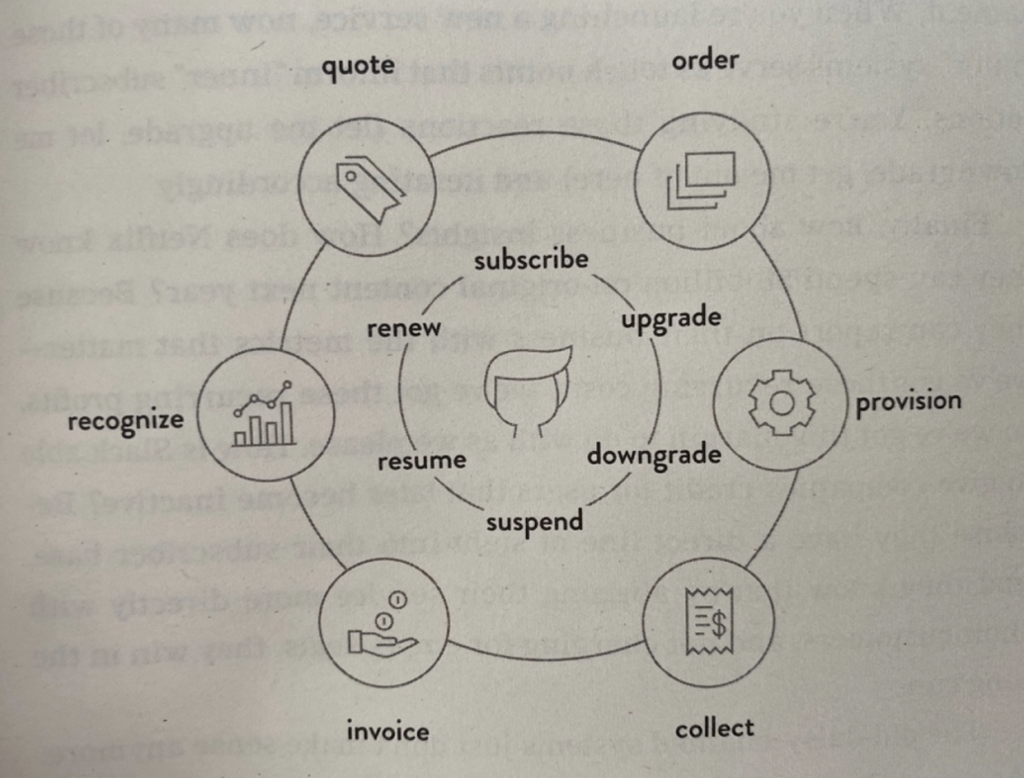
Graphic 14 – The subscription backend. [23]
- Success measurement
Opposing to the product development and launch where it becomes clear rather quickly if your new innovation will become a success, this won’t be so clear in the subscription model for quite a long time. Only after some time has passed and you begin to be able to analyze if the average consumer lifetime value is higher than your combined acquisition and running service costs during this period you will know if the model is a success. It’s a rather long-term model.
- Success?
Coming to charging for new features. This is a finite game. In a Tesla, you can buy one and the same car with features activated around 120k € or deactivated for around 80k €. The cheaper one will have all the hardware features built-in but they are blocked. You can then buy them e.g. by increasing your monthly subscription fee. There’s a limit to it. If you’ve unlocked all the features there’s no more additional hardware upselling available. This might be solved by a new product generation which obviously still will be developed according to data, but this fact only stresses the point to have a valuable service environment surrounding your product. Similar to what Apple did with the Appstore. These services give value to the product and therefore drive consumer satisfaction, willingness to pay, and retention.
- Fraud
There’s another financial dimension to a subscription model. The aspect of fraud prevention. If you sell a product the risk is moved together with the ownership to the customer. If he breaks something, it’s his fault. With a subscription, your company is pushed into the role of a bank or an investor. The consumer/ customer doesn’t receive ownership of the product so if they break something, it’s partially your problem but even worse – if they start having a problem paying the subscription or they stop paying the subscription you may end up chasing your products that are unpaid and you might have big write-offs. So the prevention of fraud and the insurance (especially in the high price segment) against broken or stolen products is important from the first day.
- Subscribing can be expensive and not in everyone’s interest
For consumers/ clients needing several subscriptions a month, it can quickly become a problem. And I am not only talking about having Disney+, HBO, Netflix, Amazon Prime Video, and Spotify to serve all the tastes of every member of the household. No just imagine a big construction company with 100s of excavators, trucks, and other machines. If all of them are subscription-based this price quickly adds up – and the newest equipment might simply not be desirable enough against the old model of using things until they break. Considering a situation like the one we currently have with a pandemic and a monthly option to cancel the subscription you as the producer of this machinery will end up with all of them back in your court earning no money but still having a bank demanding a constant cash flow for their credits (- which are also a subscription by the way). So it’s not in everybody’s interest to shift away from ownership
- Pricing might not be easy
Bringing us back to the desirability of the latest equipment. If you fail on delivering this, the subscription becomes obsolete for the subscriber. Nobody leasing a car would keep on doing so if it was sure that she would have to do so for 30 years and this would be much more expensive than paying it once now.
However, even if this might look challenging, there are some good guidelines for pricing. Like updating your pricing regularly according to data. Overlooking and identifying the core value drivers for your offering. Looking at different options between one flat fee, the introduction of tiers (from essential to anything imaginable – don’t. overdo it though and keep it simple – three are enough) and price anchors to approach different user needs and user segments or the introduction of an additional pay per use layer that lets users pay for premium features they don’t always need – giving them access and even more flexibility.
- The price will be higher
This brings us to another pricing aspect. A subscription has to have a higher price than the product. There are the costs for capital (you are playing bank), the included costs for services and repairs, the costs for updates, the costs for added value services surrounding the product, and maybe also the costs for additional experiences, not to forget the costs for the part of the fraud you won’t be able to prevent. This has to be managed and communicated transparently to a consumer. They will understand and be happy to pay a higher price over the time of the subscription if the corresponding value proposition is in their interest. Plus the subscription fee will still be a lower out of pocket than a direct purchase.
- Success is decided by a good retention management
All of these aspects bring us to the last but not least challenge to handle: retention.
Managing customer expectations, delivering on them and keeping their engagement high is key to the success of any subscription program. Only by doing this, the consumer lifetime value can be increased significantly. Cross- and Upselling works but it cannot really make up for the money you invested in getting the subscriber to sign up and to deliver the product or service you do.
For example, the churn rate of Spotify during its IPO in 2018 was 4,5% with an average consumer lifetime value of 31,1 $ with acquisition costs of 16,2 $[24] they make an average profit per user of 14,9 $ but only due to the low churn rate.
Even with all these uncertainties, it pays to consider and move towards a subscription-based business model. The biggest challenge will be change management, as the whole thinking of the company will have to move from a bring a product to market mentality to a customer-centric beta always improving mentality. The long-term benefits will probably outweigh the short-term risk.
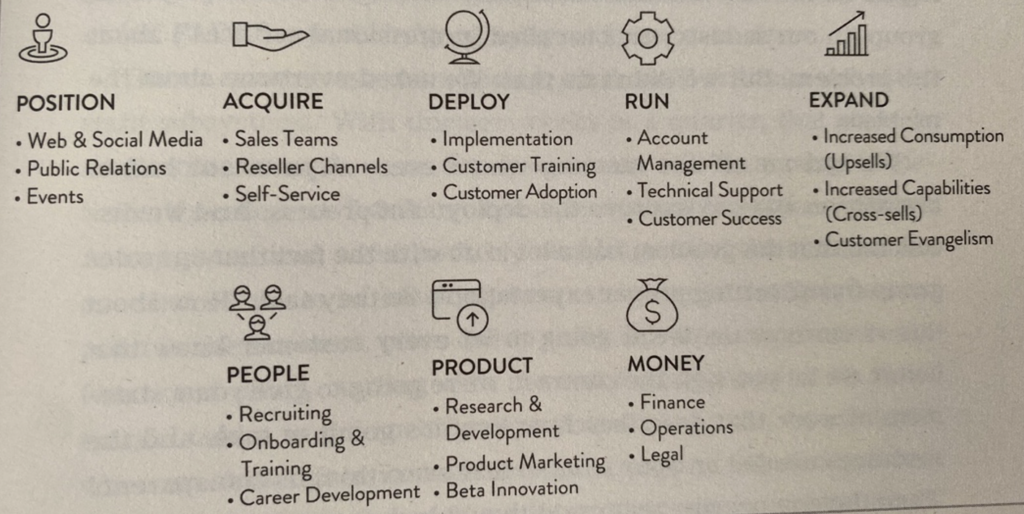
Graphic 15 – How to build a subscription culture [25]
All of this will enable you to become a better more customer-centric company – as thinking about their behavior will enable you to constantly improve on your product and service offering.
And best is not to try the big bang at once but to start slowly and dream big.
The ideal is to follow the adaptation of the lean startup approach. First, start to concept your subscription and test it in a smoke test. This can be handled by building a click dummy with an example value proposition and inviting an existing consumer base and tracking their actions. Would they sign up? Do they click the button that says keep me up to date and tell me when it’s life?

Graphic 16 – Keep it simple
If this first step and kind of the proof of concept are done, we move towards the real MVP. The minimum viable product. So a baseline subscription model includes only one basic service. This will keep the tech investment and the change investment for the company manageable and produce sufficient insights to see how a subscription will perform. Don’t move your whole company to a subscription model directly.
After this MVP you might want to use the learnings and attract additional customer segments. This is the moment to introduce tiers. They work in two different ways. On the one side, they can have different value propositions tailored to a specific customer segment and they can be used for price anchoring with the most popular mid-prized offer in the middle. Similar to the wine example we all know from the supermarket. Don’t create 50 tiers one for each sub-sub-sub-segment of every imaginable target audience. This will make it incomprehensible for the consumer and they won’t be able to make up their mind and decide for any of the tiers.
If you’ve made it so far, the end-boss of subscriptions is personalization. This requires a high availability of consumer data and an understanding of the same. A highly advanced tech-stack and if products are involved a highly efficient fulfillment. I’ve put Hello fresh in this category because personally, I think it’s closest to this as you can select your menu for the following week from a selection close to your diet, but even here, I think the space for improvement is extreme. To give a simple example – why can I only choose between with or without meat, why not have one recipe and let me select the type of meat or tofu I want, the type of noodles I want, and maybe even say I am not a fan of broccoli please change that for cauliflower? This would be real personalization – and would potentially increase my consumer satisfaction again as it slowly starts being the same menus again and again and again. Also, there are insufficient services surrounding it. If you are reading this @HelloFresh – where is the direct tracer of the nutrition information to my lifesum and apple health app? Where’s the connection to my Freeletics account and recommendations on the food I select according to my training plan? -> Give me a call. I have a ton more.
One more thing
be aware of the legal framework.
I’ll keep it brief here. Not every product can be delivered as a subscription. Just consider a Schnapps subscription. The PR fallout might kill the project rather quickly. Subscription for bullets? Probably similar. Any subscription will have legal issues to manage.
- Guiding principles
The first question you should ask yourself is if your product or service can be transferred towards a subscription model. If the answer is yes. Someone somewhere will do it and the only remaining question is only when. So the sooner you start developing a perspective on the topic and one or two possible ways to move towards the model and to maybe even test it the better it is. There surely also will be some offers where it simply won’t work and doesn’t make sense.
To kickstart you, here are some guiding principles you can start with that count for most subscriptions:
Subscriptions should always consist of Products and services. The product should be the enabler for added values through the service and a perfect consumer experience. Where are we today? Do we have a service? Then what could be the product? And vice versa.
Attractive acquisition – for new subscribers it has to be easy and the risk has to be small for them to start the subscription. Can we manage these acquisition costs later down the road?
Personalization/ Adaptation – to keep subscribers in the subscription we have to enable a high degree of personalization for them. Can we do this on a product or a service base – or maybe both?
Products and services – should be modular to upgrade, downgrade, and keep a base product that can then be improved. Can we make this technically possible?
Get and use data – it won’t lie and give a real advantage over other players in the market. Which data could this be? Do we need to adapt our product for this?
Ultimate flexibility – any subscription offer has to give the highest possible degree of flexibility to the consumer or client. Can we manage the financial burden coming with this?
Longevity/ Sustainability – will your product but also your service framework live long enough and can it be used long enough by a customer that it will produce a profit over time?
Is Ownership desirable for our product? Can the subscription then be payment installments? And can we increase the Consumer Lifetime value through services that she keeps on paying after these payments are finished? Or can we move towards the PaaS model?
Is what we are concepting really improving the overall consumer experience? Is it customer-centric?
And can it, therefore, be successful?
Thank you very much for reading
and as always like, comment, share, and subscribe to our channel.
Ogilvy Consulting
8 About Ogilvy Consulting
How we can help you move to a subscription-based business model
Ogilvy Consulting – a worldwide network of experts
In times of an exponentially changing world, creative ideas alone are not enough.
If you want to offer a contemporary brand experience today, you have to be agile, efficient and goal-oriented. At eye level with our clients, we combine in-depth knowledge of people and brands with expertise in digital transformation, technology and innovation. Our goal: to help brands remain relevant in our complex world.
As a boutique consultancy in the WPP cosmos and with a global network of consultants, we support our clients in business design, growth and innovation strategies and digital transformation. This begins with strategy consulting and extends to creation and implementation.
Worldwide
300+ Senior Consultants & Specialist Experts
3,000+ consultants
Why do we put people at the center?
The human being is in the foreground with us. Because a digital product cannot function without understanding the user. Therefore, technology is only a means to an end for us.
What we offer
Growth & Innovation
– Growth strategies
– New business models
– Capability Transformation
Business design
– Brand strategy
– Marketing strategy
– Customer Experience Strategy
Digital transformation
– Consulting on digital transformation
– digital experience
– Digital Innovation
The future is digital – but man-made.
Your key contacts
Bernd Kunkel
Consulting Director & subscription specialist
Bernd Kunkel is Consulting Director at Ogilvy Consulting Germany, based in Frankfurt. With more than 10 years of experience in marketing & consulting, Bernd sets his focus on creating the best customer experience through a combination of analog and digital – enabling growth and innovation through products and services.
Up until now, he worked for more than 70 different brands across different industries and segments, on an inter-/ national and local level including Allgeier Experts, BOSCH, Deutsche Hospitality, doremi, IBM, IQOS, Edeka, MAHLE, Merck, Nespresso, PharmaLex, Saint Gobain, Samsung, Telespazio Vega, TUI or xarvio.
Bernd has worked in account- & project management, strategy, and executive roles in agencies, companies, and his own startups in the past, giving him experiences from advertising and CRM via live marketing and events to digital solutions, business- & product development.
This gives him a generalist background in marketing & communications, business, and digital topics with selected focus areas (e.g. digital transformation, employer branding, business design modeling, prototyping, social media, tech…). His entrepreneurial background enables Bernd to have a holistic view of projects and to develop solutions and ideas for big and small challenges alike.
Husband, father, engaged entrepreneur, gooder, philosopher, grown up in the 90s. I still know analog and. live digital Let’s connect the best of both.
“Do it or don’t. There is no try.” – Yoda
Birgit Baier
consulting partner
Birgit Baier is Consulting Partner at Ogilvy Germany and heads the consulting team in Berlin, Frankfurt and Düsseldorf. She has more than 25 years of experience in strategic consulting for numerous industries and over 50 brands in 20 countries on three continents.
She uses her accumulated experience to create brands, solutions, products, services and brand experiences as well as strategic innovations for international clients. Technology and strategic change are among the topics she has advised on to date for clients such as Ford, Audi, BMW, Citibank, ING Bank, Amex, Swiss, KLM, P&G, Nestlé, Mars, Kraft Foods, Vodafone, Telefonica, Alcatel, Nokia, IBM, DHL, Bosch, Siemens, IKEA, McDonald’s and UNICEF.
Before joining Ogilvy, Birgit worked as a strategic consultant and lecturer at the Macromedia University in Berlin. In recent years she has worked for several well-known agencies, including Wunderman, FutureBrand, Frog Design, Brand Union, and SapientRazorfish.
„Berlin is my city and the world is my home“ says the enthusiastic motorcyclist, who loves traveling, reading, movies, and old European motorbikes. Along the way, she works with other people to find sustainable solutions for a better life for children and women of Nepal.
Sources:
[1] https://www.bbc.com/news/business-48760799
[2] https://www.cbinsights.com/research/startup-failure-reasons-top/
[3] https://www.wsj.com/articles/quibi-weighs-shutting-down-as-problems-mount-11603301946
[4] thinking inside the subscription box: New research on e-commerce consumers McKinsey (2018)
[5] Forrester – The_Rise_Of_The_Subscription
[6] the subscription economy index Zuora 2019
[7] thinking inside the subscription box: New research on e-commerce consumers McKinsey (2018)
[8] thinking inside the subscription box: New research on e-commerce consumers McKinsey (2018)
[9] Sign up now: Creating consumer—and business— value with subscriptions McKinsey (2021)
[10] thinking inside the subscription box: New research on e-commerce consumers McKinsey (2018)
[11] Forrester – The_Rise_Of_The_Subscript
[12] https://www.emarketer.com/Article/Sharing-Economy-Users-Desire-Access-Over-Ownership/1012429
[13] https://www.salesforce.com/research/customer-expectations/ State of connected customer report 2020
[14] https://www.on-running.com/de-de/cyclon?utm_source=facebook&utm_medium=post&utm_campaign=cyclon-launch&fbclid=IwAR3vdKeRQ9td7WMuy5-ATdRKmJ84sCWcayHGxV7cjkRNk1nmEWtqE6fOqBk
[15] thinking inside the subscription box: New research on e-commerce consumers McKinsey (2018)
[16] thinking inside the subscription box: New research on e-commerce consumers McKinsey (2018)
[17] https://www.bundesregierung.de/breg-de/suche/faire-verbrauchervertraege-1829172
[18] thinking inside the subscription box: New research on e-commerce consumers McKinsey (2018)
[19] thinking inside the subscription box: New research on e-commerce consumers McKinsey (2018)
[20] Tien Tzuo – subscribed – why the subscription model will be your company’s future – and what to do about it
[21] Free after Forrester – The_Rise_Of_The_Subscript
[22] Tien Tzuo – subscribed – why the subscription model will be your company’s future – and what to do about it
[23] Tien Tzuo – subscribed – why the subscription model will be your company’s future – and what to do about it
[24] https://blog.chartmogul.com/metrics-behind-spotifys-ipo/ & https://medium.com/@anuj.shah/how-much-does-a-subscriber-worth-to-spotify-4b259887eefd
[25] Tien Tzuo – subscribed – why the subscription model will be your company’s future – and what to do about it
Wow Thanks for this publish i find it hard to locate great specifics out there when it comes to this content thank for the site website
Happy to. If you have any additional questions lmk.
nice blog mate.. amazing content.. this one i search for. thank you
Wow Thanks for this thread i find it hard to track down beneficial information out there when it comes to this content appreciate for the article site
Wow Thanks for this guide i find it hard to come across excellent related information out there when it comes to this material thank for the write-up site
This is a truly clear post. As someone who blogs, I found this especially applicable. If you’re interested, I recently wrote something similar on my site too. Keep up the solid work!